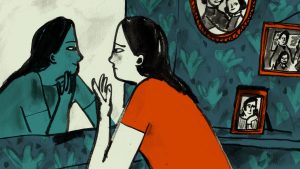Historical influences and the rise in prejudices against Asian Americans bred inward feelings of guilt, shame, and confusion. For people of color, the desire to become white is a common experience, which Nellie Wong encapsulates in her poem, “When I Was Growing Up”:
when I was growing up, I felt
dirty. I thought that god
made white people clean
and no matter how much I bathed,
I could not change, I could not shed
my skin in the gray water. (Wong 6)
The shame of being Asian American was magnified by the struggle between ethnicity and gender as “women of color are often made to feel that we must make a choice between the two” (Yamada 70). Asian American women were often shamed when choosing to advocate exclusively for women’s rights by men who argued that such a choice would create unrectifiable divides between Asian American men and women.

This illustration by artist Gracey Zhang illustrates inward feelings of confusion surrounding the Asian American identity
The exploitation of Asian cultural identities and forced assimilation into a white-dominant society further exacerbates confusion at the individual and community levels. Whites manipulate Asian Americans’ perception of their identity for personal benefit: “In wartime, it was charged that the Japanese were clannish and ‘unassimilable.’ Today, the consensus is that the Japanese American’s power of accommodation is not only phenomenal, but it is “rarely equaled” (Ikeda-Speigel 96). Furthermore, white society perpetuates the model minority myth by adjusting Asian Americans’ proximity to whiteness at their whim, thus promoting harmful racial stereotypes and dehumanizing the Asian American community. In addition, whites appropriate Asian culture and label it as “exotic” and “oriental” while simultaneously claiming that it is “dirty, evil, and wrong” (Pegues 15). As such, Asian Americans are reluctant to embrace their heritage in order to assimilate and reject their culture by adhering to Western standards and norms. As Pegues states, “colonization runs deep,” and Asian Americans are pushed to abandon integral aspects of their cultural identity in pursuit of community.
In a hopeless bid for acceptance into white spaces, Asian Americans are conditioned “not to expect a response in ways that matter” (Yamada 34). Consequently, Asian American women unknowingly adopt a mentality of passive resistance and resort to assimilation in a society that operates exclusively for white males. Asian Americans distance themselves from their cultural heritage by struggling to fit into a rigid mold: “transplantation had created cultural barriers which could not be bridged… ” (Ho 60). As Liang Ho suggests, Asian American women aren’t perceived as “all-American” nor can they fit into their “ancestral ethnic shoes” (60). Whites first view Asian Americans as “exotic Orientals” while Asians view Asian Americans as “rich capitalist Americans,” forcing Asian Americans to compromise between a “double image” that is forced upon them (Ho 60).
Sources:
Pegues, Juliana. “White Christmas.” Sinister Wisdom. Vol. 54, 01 Jan. 1995, pp. 15-21.
Ho, Liang. “Asian-American Women: Identity and Role in the Women’s Movement.” Heresies: A Feminist Publication on Art and Politics, vol. 4 no. 3, 01 Jul. 1982, pp. 60-61.
Wong, Nellie. “When I Was Growing Up.” Yamada, Mitsuye. “Asian Pacific American Women and Feminism.” This Bridge Called My Back: Writings by Radical Women of Color, by Moraga Cherríe and Anzaldúa Gloria, 4th ed., SUNY Press., 2015, pp. 5-6.
Yamada, Mitsuye. “Invisibility is an Unnatural Disaster: Reflections of An Asian American Woman.” This Bridge Called My Back: Writings by Radical Women of Color, by Moraga Cherríe and Anzaldúa Gloria, 4th ed., SUNY Press., 2015, pp. 30–35.
Yamada, Mitsuye. “Asian Pacific American Women and Feminism.” This Bridge Called My Back: Writings by Radical Women of Color, by Moraga Cherríe and Anzaldúa Gloria, 4th ed., SUNY Press., 2015, pp. 68-72.
